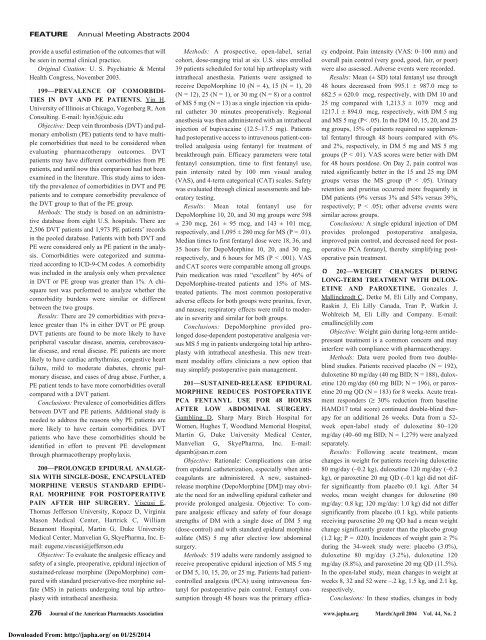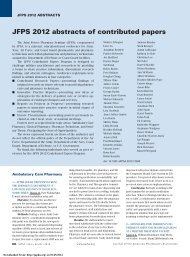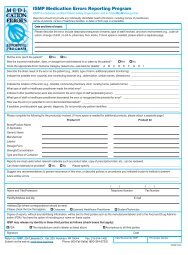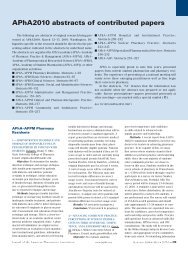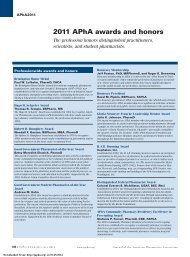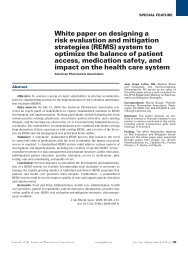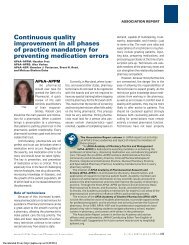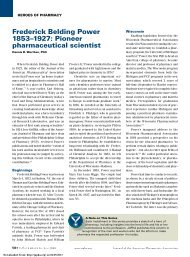Downloaded - Journal of American Pharmacists Association
Downloaded - Journal of American Pharmacists Association
Downloaded - Journal of American Pharmacists Association
You also want an ePaper? Increase the reach of your titles
YUMPU automatically turns print PDFs into web optimized ePapers that Google loves.
FEATURE Annual Meeting Abstracts 2004<br />
provide a useful estimation <strong>of</strong> the outcomes that will<br />
be seen in normal clinical practice.<br />
Original Citation: U. S. Psychiatric & Mental<br />
Health Congress, November 2003.<br />
199—PREVALENCE OF COMORBIDI-<br />
TIES IN DVT AND PE PATIENTS. Yin H,<br />
University <strong>of</strong> Illinois at Chicago, Vogenberg R, Aon<br />
Consulting. E-mail: hyin3@uic.edu<br />
Objective: Deep vein thrombosis (DVT) and pulmonary<br />
embolism (PE) patients tend to have multiple<br />
comorbidities that need to be considered when<br />
evaluating pharmacotherapy outcomes. DVT<br />
patients may have different comorbidities from PE<br />
patients, and until now this comparison had not been<br />
examined in the literature. This study aims to identify<br />
the prevalence <strong>of</strong> comorbidities in DVT and PE<br />
patients and to compare comorbidity prevalence <strong>of</strong><br />
the DVT group to that <strong>of</strong> the PE group.<br />
Methods: The study is based on an administrative<br />
database from eight U.S. hospitals. There are<br />
2,506 DVT patients and 1,973 PE patients’ records<br />
in the pooled database. Patients with both DVT and<br />
PE were considered only as PE patient in the analysis.<br />
Comorbidities were categorized and summarized<br />
according to ICD-9-CM codes. A comorbidity<br />
was included in the analysis only when prevalence<br />
in DVT or PE group was greater than 1%. A chisquare<br />
test was performed to analyze whether the<br />
comorbidity burdens were similar or different<br />
between the two groups.<br />
Results: There are 29 comorbidities with prevalence<br />
greater than 1% in either DVT or PE group.<br />
DVT patients are found to be more likely to have<br />
peripheral vascular disease, anemia, cerebrovascular<br />
disease, and renal disease. PE patients are more<br />
likely to have cardiac arrhythmias, congestive heart<br />
failure, mild to moderate diabetes, chronic pulmonary<br />
disease, and cases <strong>of</strong> drug abuse. Further, a<br />
PE patient tends to have more comorbidities overall<br />
compared with a DVT patient.<br />
Conclusions: Prevalence <strong>of</strong> comorbidities differs<br />
between DVT and PE patients. Additional study is<br />
needed to address the reasons why PE patients are<br />
more likely to have certain comorbidities. DVT<br />
patients who have these comorbidities should be<br />
identified in effort to prevent PE development<br />
through pharmacotherapy prophylaxis.<br />
200—PROLONGED EPIDURAL ANALGE-<br />
SIA WITH SINGLE-DOSE, ENCAPSULATED<br />
MORPHINE VERSUS STANDARD EPIDU-<br />
RAL MORPHINE FOR POSTOPERATIVE<br />
PAIN AFTER HIP SURGERY. Viscusi E,<br />
Thomas Jefferson University, Kopacz D, Virginia<br />
Mason Medical Center, Hartrick C, William<br />
Beaumont Hospital, Martin G, Duke University<br />
Medical Center, Manvelian G, SkyePharma, Inc. E-<br />
mail: eugene.viscusi@jefferson.edu<br />
Objective: To evaluate the analgesic efficacy and<br />
safety <strong>of</strong> a single, preoperative, epidural injection <strong>of</strong><br />
sustained-release morphine (DepoMorphine) compared<br />
with standard preservative-free morphine sulfate<br />
(MS) in patients undergoing total hip arthroplasty<br />
with intrathecal anesthesia.<br />
Methods: A prospective, open-label, serial<br />
cohort, dose-ranging trial at six U.S. sites enrolled<br />
39 patients scheduled for total hip arthroplasty with<br />
intrathecal anesthesia. Patients were assigned to<br />
receive DepoMorphine 10 (N = 4), 15 (N = 1), 20<br />
(N = 12), 25 (N = 1), or 30 mg (N = 8) or a control<br />
<strong>of</strong> MS 5 mg (N = 13) as a single injection via epidural<br />
catheter 30 minutes preoperatively. Regional<br />
anesthesia was then administered with an intrathecal<br />
injection <strong>of</strong> bupivacaine (12.5–17.5 mg). Patients<br />
had postoperative access to intravenous patient-controlled<br />
analgesia using fentanyl for treatment <strong>of</strong><br />
breakthrough pain. Efficacy parameters were total<br />
fentanyl consumption, time to first fentanyl use,<br />
pain intensity rated by 100 mm visual analog<br />
(VAS), and 4-term categorical (CAT) scales. Safety<br />
was evaluated through clinical assessments and laboratory<br />
testing.<br />
Results: Mean total fentanyl use for<br />
DepoMorphine 10, 20, and 30 mg groups were 598<br />
± 230 mcg, 261 ± 95 mcg, and 143 ± 101 mcg,<br />
respectively, and 1,095 ± 280 mcg for MS (P = .01).<br />
Median times to first fentanyl dose were 18, 36, and<br />
35 hours for DepoMorphine 10, 20, and 30 mg,<br />
respectively, and 6 hours for MS (P < .001). VAS<br />
and CAT scores were comparable among all groups.<br />
Pain medication was rated “excellent” by 46% <strong>of</strong><br />
DepoMorphine-treated patients and 15% <strong>of</strong> MStreated<br />
patients. The most common postoperative<br />
adverse effects for both groups were pruritus, fever,<br />
and nausea; respiratory effects were mild to moderate<br />
in severity and similar for both groups.<br />
Conclusions: DepoMorphine provided prolonged<br />
dose-dependent postoperative analgesia versus<br />
MS 5 mg in patients undergoing total hip arthroplasty<br />
with intrathecal anesthesia. This new treatment<br />
modality <strong>of</strong>fers clinicians a new option that<br />
may simplify postoperative pain management.<br />
201—SUSTAINED-RELEASE EPIDURAL<br />
MORPHINE REDUCES POSTOPERATIVE<br />
PCA FENTANYL USE FOR 48 HOURS<br />
AFTER LOW ABDOMINAL SURGERY.<br />
Gambling D, Sharp Mary Birch Hospital for<br />
Women, Hughes T, Woodland Memorial Hospital,<br />
Martin G, Duke University Medical Center,<br />
Manvelian G, SkyePharma, Inc. E-mail:<br />
dgamb@san.rr.com<br />
Objective: Rationale: Complications can arise<br />
from epidural catheterization, especially when anticoagulants<br />
are administered. A new, sustainedrelease<br />
morphine (DepoMorphine [DM]) may obviate<br />
the need for an indwelling epidural catheter and<br />
provide prolonged analgesia. Objective: To compare<br />
analgesic efficacy and safety <strong>of</strong> four dosage<br />
strengths <strong>of</strong> DM with a single dose <strong>of</strong> DM 5 mg<br />
(dose-control) and with standard epidural morphine<br />
sulfate (MS) 5 mg after elective low abdominal<br />
surgery.<br />
Methods: 519 adults were randomly assigned to<br />
receive preoperative epidural injection <strong>of</strong> MS 5 mg<br />
or DM 5, 10, 15, 20, or 25 mg. Patients had patientcontrolled<br />
analgesia (PCA) using intravenous fentanyl<br />
for postoperative pain control. Fentanyl consumption<br />
through 48 hours was the primary efficacy<br />
endpoint. Pain intensity (VAS: 0–100 mm) and<br />
overall pain control (very good, good, fair, or poor)<br />
were also assessed. Adverse events were recorded.<br />
Results: Mean (± SD) total fentanyl use through<br />
48 hours decreased from 995.1 ± 987.0 mcg to<br />
682.5 ± 620.0 mcg, respectively, with DM 10 and<br />
25 mg compared with 1,213.3 ± 1079 mcg and<br />
1217.1 ± 894.0 mcg, respectively, with DM 5 mg<br />
and MS 5 mg (P< .05). In the DM 10, 15, 20, and 25<br />
mg groups, 15% <strong>of</strong> patients required no supplemental<br />
fentanyl through 48 hours compared with 6%<br />
and 2%, respectively, in DM 5 mg and MS 5 mg<br />
groups (P < .01). VAS scores were better with DM<br />
for 48 hours postdose. On Day 2, pain control was<br />
rated significantly better in the 15 and 25 mg DM<br />
groups versus the MS group (P < .05). Urinary<br />
retention and pruritus occurred more frequently in<br />
DM patients (9% versus 3% and 54% versus 39%,<br />
respectively; P < .05); other adverse events were<br />
similar across groups.<br />
Conclusions: A single epidural injection <strong>of</strong> DM<br />
provides prolonged postoperative analgesia,<br />
improved pain control, and decreased need for postoperative<br />
PCA fentanyl, thereby simplifying postoperative<br />
pain treatment.<br />
202—WEIGHT CHANGES DURING<br />
LONG-TERM TREATMENT WITH DULOX-<br />
ETINE AND PAROXETINE. Gonzales J,<br />
Mallinckrodt C, Detke M, Eli Lilly and Company,<br />
Raskin J, Eli Lilly Canada, Tran P, Watkin J,<br />
Wohlreich M, Eli Lilly and Company. E-mail:<br />
cmallinc@lilly.com<br />
Objective: Weight gain during long-term antidepressant<br />
treatment is a common concern and may<br />
interfere with compliance with pharmacotherapy.<br />
Methods: Data were pooled from two doubleblind<br />
studies. Patients received placebo (N = 192),<br />
duloxetine 80 mg/day (40 mg BID; N = 188), duloxetine<br />
120 mg/day (60 mg BID; N = 196), or paroxetine<br />
20 mg QD (N = 183) for 8 weeks. Acute treatment<br />
responders (≥ 30% reduction from baseline<br />
HAMD17 total score) continued double-blind therapy<br />
for an additional 26 weeks. Data from a 52-<br />
week open-label study <strong>of</strong> duloxetine 80–120<br />
mg/day (40–60 mg BID; N = 1,279) were analyzed<br />
separately.<br />
Results: Following acute treatment, mean<br />
changes in weight for patients receiving duloxetine<br />
80 mg/day (–0.2 kg), duloxetine 120 mg/day (–0.2<br />
kg), or paroxetine 20 mg QD (–0.1 kg) did not differ<br />
significantly from placebo (0.1 kg). After 34<br />
weeks, mean weight changes for duloxetine (80<br />
mg/day: 0.8 kg; 120 mg/day: 1.0 kg) did not differ<br />
significantly from placebo (0.1 kg), while patients<br />
receiving paroxetine 20 mg QD had a mean weight<br />
change significantly greater than the placebo group<br />
(1.2 kg; P = .020). Incidences <strong>of</strong> weight gain ≥ 7%<br />
during the 34-week study were: placebo (3.0%),<br />
duloxetine 80 mg/day (3.2%), duloxetine 120<br />
mg/day (8.8%), and paroxetine 20 mg QD (11.5%).<br />
In the open-label study, mean changes in weight at<br />
weeks 8, 32 and 52 were –.2 kg, 1.5 kg, and 2.1 kg,<br />
respectively.<br />
Conclusions: In these studies, changes in body<br />
276 <strong>Journal</strong> <strong>of</strong> the <strong>American</strong> <strong>Pharmacists</strong> <strong>Association</strong> www.japha.org March/April 2004 Vol. 44, No. 2<br />
<strong>Downloaded</strong> From: http://japha.org/ on 01/25/2014


